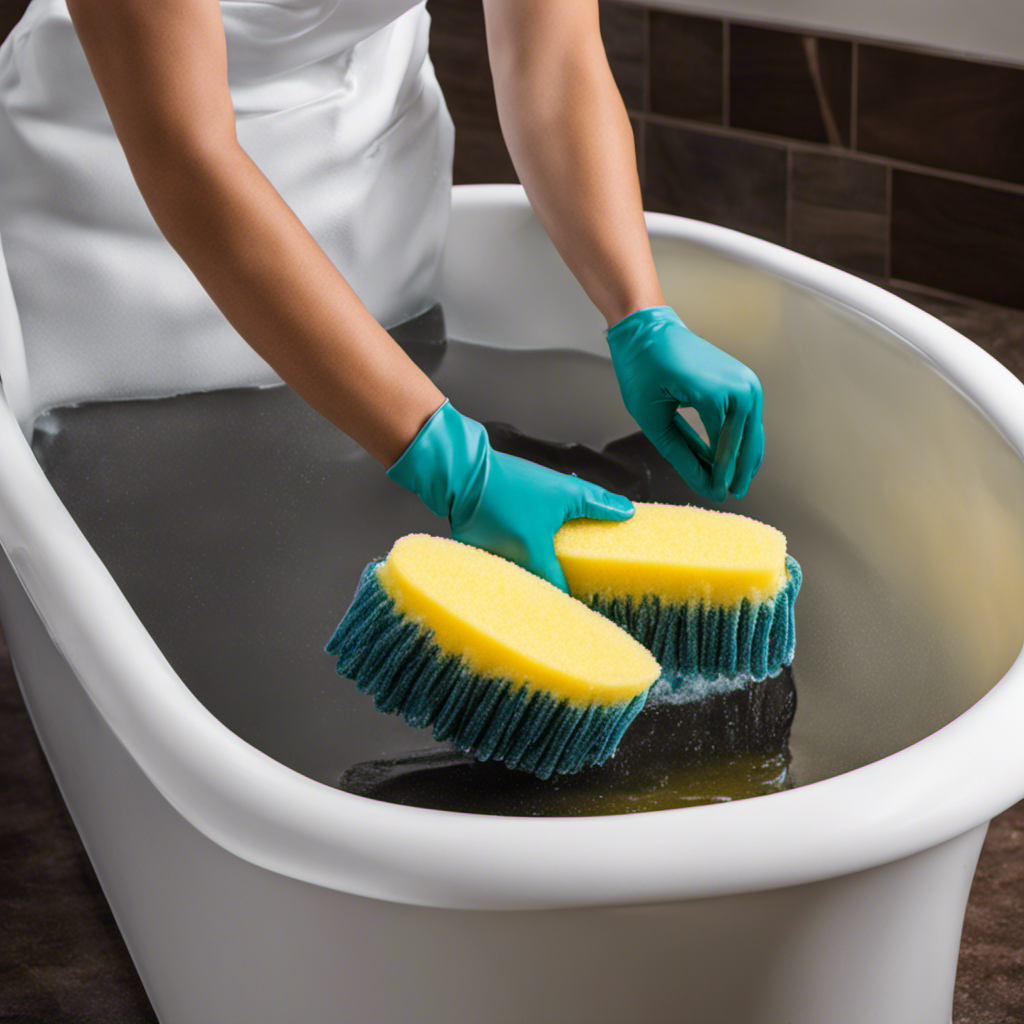Did you know that the average American household does approximately 400 loads of laundry each year? That’s a lot of time and money spent at the laundromat or waiting for the washer to finish.
But what if I told you there’s a more cost-effective and convenient way to get your clothes clean? In this article, I’ll show you how to wash your clothes in the bathtub using simple supplies you already have at home.
It’s a practical solution for those who want to save time, money, and energy.
Let’s get started!
Key Takeaways
- Gather all necessary laundry supplies and choose the best detergent option based on your needs.
- Sort clothes into whites, lights, and darks, and further separate them based on fabric type and temperature requirements.
- Pre-treat stains and heavily soiled areas before washing to increase the chances of removing them.
- Fill the bathtub with water, adjusting the temperature and water level based on fabric requirements, to ensure all clothes are fully submerged.
Gathering Your Laundry Supplies
Before you start, make sure you’ve gathered all of your laundry supplies. It’s important to have everything you need within reach to make the process smoother.
When it comes to laundry detergent options, you can choose between powdered or liquid detergents. Powdered detergents are great for stains and odors, while liquid detergents are gentle on delicate fabrics.
Additionally, you may want to consider alternative washing methods if you don’t have access to a washing machine. One option is using vinegar and baking soda as a natural detergent. Another alternative is using a gentle soap bar or shampoo. These options can be effective in cleaning your clothes, especially if you have sensitive skin or prefer a more eco-friendly approach.
Remember to gather your supplies and choose the best detergent option for your needs.
Sorting Your Clothes by Color and Fabric Type
To properly sort your laundry, you’ll want to start by separating your clothes based on color and fabric type. This step is crucial to ensure that your clothes are washed effectively and maintain their quality. Here are some key tips for color sorting and fabric type:
-
Sort your clothes into three main piles: whites, lights, and darks. This will prevent colors from bleeding onto each other and keep your whites bright.
-
Check the care labels on your clothes to determine the fabric type. Separate delicate fabrics, such as silk or lace, from sturdier fabrics like denim or cotton.
-
Consider sorting your clothes further based on temperature requirements. Some fabrics, like wool or cashmere, require cold water while others can be washed in warm or hot water.
-
Don’t forget to empty your pockets and remove any items that may cause damage to your clothes during the washing process.
-
Lastly, if you have heavily soiled items, it’s best to wash them separately or pre-treat them before adding them to the rest of your laundry.
Pre-Treating Stains and Heavily Soiled Areas
When dealing with stains and heavily soiled areas, it’s important to pre-treat them before washing to ensure the best results.
There are various pre-treating methods and stain removal techniques that can be used depending on the type of stain and fabric.
For example, for oil-based stains, applying a small amount of dish soap directly to the stain and gently rubbing it in can help break down the oil.
For protein-based stains like blood or sweat, soaking the garment in cold water with enzyme-based stain removers can be effective.
It’s also important to read the care labels on your clothes to determine the best pre-treating method.
By pre-treating stains, you increase the chances of completely removing them during the washing process, leaving your clothes looking clean and fresh.
Now, let’s move on to filling the bathtub with the right amount of water.
Filling the Bathtub With the Right Amount of Water
Now that you’ve determined the appropriate amount of water, go ahead and fill the bathtub accordingly. It is crucial to get the bathtub water level just right for an effective clothes washing experience. Here are some key points to consider:
-
Water temperature: Adjust the water temperature to match the fabric requirements. Hot water is ideal for whites and heavily soiled items, while cold water is suitable for delicate fabrics and colors that may bleed.
-
Fill the tub halfway: Aim to fill the tub halfway, ensuring enough space for the clothes to move around freely during the wash cycle. Overcrowding the tub can hinder the cleaning process.
-
Submerge the clothes: Ensure that all the clothes are fully submerged in water to allow for thorough cleaning. Use your hands to gently agitate the water and create movement.
-
Avoid excessive water: While it’s important to have enough water for the clothes to move, avoid filling the tub excessively to conserve water and prevent unnecessary wastage.
-
Monitor water levels: Keep an eye on the water levels throughout the wash to ensure it remains consistent. If needed, you can adjust the water level by adding more or draining some out.
Adding Detergent and Agitating the Clothes
When it comes to adding detergent and agitating clothes in the bathtub, there are a few key points to keep in mind.
First and foremost, it is crucial to measure the detergent properly to ensure effective cleaning. Using too little may result in inadequate cleaning, while using too much can leave residue on the clothes.
Secondly, employing effective agitation techniques is essential to loosen dirt and grime from the fabric. This can be achieved by gently swishing the clothes in the water or using a plunger to create a more vigorous motion.
Lastly, considering the water temperature is crucial as it can affect the effectiveness of the detergent. Hot water is ideal for removing stains and grease, while cold water is better suited for delicate fabrics.
Proper Detergent Measurement
To properly measure your detergent, make sure you’re using the recommended amount for each load. This is crucial for achieving clean and fresh-smelling clothes.
Here are some tips to help you with proper detergent measurement:
-
Read the instructions: Different detergents have different guidelines for measuring. Always refer to the instructions on the packaging.
-
Use measuring tools: Invest in a measuring cup or use the cup that comes with your detergent. This ensures accuracy.
-
Consider load size: Adjust the amount of detergent based on the size of your load. Larger loads may require more detergent.
-
Focus on water hardness: Hard water requires more detergent compared to soft water. Refer to your detergent’s instructions for guidance.
-
Choose the right detergent: Some detergents are specifically designed for high-efficiency machines or delicate fabrics. Select the appropriate one for your needs.
Effective Agitation Techniques
Using the right amount of detergent and employing effective agitation techniques will help remove dirt and stains from your clothing.
When hand washing in the bathtub, it’s important to agitate your clothes properly to ensure a thorough clean. One effective technique is to gently swish the clothing back and forth in the water. This motion helps to loosen dirt and grime from the fabric fibers.
For tougher stains, you can also try rubbing the fabric together or using a soft brush to scrub the affected area. Remember to be gentle to avoid damaging the fabric.
Agitation techniques are crucial in ensuring that the detergent penetrates the fabric and lifts away dirt and stains.
Water Temperature Considerations
It’s important to consider the water temperature when hand washing clothes. The temperature of the water can have a significant impact on the effectiveness of the cleaning process and the overall quality of the results. Here are some key points to keep in mind when it comes to water temperature and hand washing clothes:
-
Hot water: Hot water is great for removing stains and killing bacteria, but it can also cause colors to fade and fabrics to shrink.
-
Cold water: Cold water is ideal for delicate fabrics and dark colors, as it helps to preserve their integrity while still providing a thorough clean.
-
Warm water: Warm water strikes a balance between hot and cold, providing effective cleaning power without being too harsh on fabrics.
-
Optimizing water usage: Consider using a basin or tub that is the appropriate size for your load of laundry to minimize water waste.
-
Energy efficiency: Using cold water whenever possible can help reduce energy consumption and lower your utility bills.
Considering these factors, it’s important to choose the right water temperature for your specific laundry needs.
Now, let’s move on to the next step: rinsing and wringing out the clothes.
Rinse and Wring Out the Clothes
After soaking the clothes in soapy water, gently rinse and wring them out to remove excess detergent. This step is essential to ensure that your clothes are thoroughly cleaned and ready for drying. Rinse techniques vary depending on the fabric and the desired outcome. For delicate items, such as lace or silk, it’s best to use cold water and avoid excessive rubbing or squeezing. For tougher fabrics like denim or cotton, you can use warm water and gently agitate the clothes to remove any remaining soap residue. Once rinsed, it’s time to wring out the clothes. Be careful not to twist or wring too hard, as this can damage the fabric. Instead, gently squeeze out the water using your hands or a towel. Now, your clothes are ready to be dried using various methods, such as air drying or using a clothesline.
| Fabric Type | Rinse Technique | Drying Method |
|---|---|---|
| Delicate | Cold water | Air drying |
| Denim | Warm water | Clothesline |
| Cotton | Warm water | Air drying |
| Silk | Cold water | Flat drying |
| Lace | Cold water | Clothesline |
Drying Your Clothes Properly
When it comes to drying clothes, there are two main options to consider: air drying vs. machine drying.
Air drying is a more environmentally friendly choice, as it uses no electricity and allows the clothes to dry naturally.
However, machine drying can be more convenient and time-saving, especially if you have a large load of laundry to dry.
Another option is hanging clothes indoors, which can be a practical solution during rainy or cold weather.
Air Drying Vs. Machine
To dry your clothes, you can choose between air drying or using a machine. Here are some key points to consider:
-
Air drying benefits:
-
Saves energy and reduces utility bills.
-
Helps extend the lifespan of your clothes.
-
Prevents shrinkage and damage caused by high heat.
-
Natural fresh air scent.
-
Environmentally friendly option.
-
Machine drying disadvantages:
-
Uses a significant amount of energy.
-
Can cause clothes to shrink or fade.
-
May damage delicate fabrics.
-
Increases the risk of static electricity.
-
Removes the natural scent of clothes.
Overall, air drying provides numerous benefits such as energy savings, garment longevity, and environmental friendliness. While machine drying offers convenience, it also comes with potential disadvantages that can affect the quality and lifespan of your clothes. It’s worth considering air drying as a more sustainable and gentle option for drying your laundry.
Hanging Clothes Indoors
After discussing the benefits of air drying clothes versus using a machine, let’s explore the option of hanging clothes indoors. While hanging clothes outdoors allows them to soak up the fresh air and sunlight, sometimes it may not be possible due to weather conditions or lack of outdoor space. Hanging clothes indoors can be a convenient alternative, especially during the colder months or in apartments without balconies. Not only does it save energy, but it also prevents wear and tear caused by machine drying. To illustrate the benefits, here’s a table:
| Benefits of Hanging Clothes Indoors |
|---|
| 1. Saves energy |
| 2. Preserves fabric quality |
| 3. Reduces static electricity |
Conclusion
In conclusion, washing your clothes in the bathtub can be a practical and efficient way to keep your garments clean and fresh. By following the steps outlined in this article, you can ensure that your clothes are properly sorted, treated, and washed.
Remember to rinse and wring out your clothes thoroughly before drying them to avoid any potential damage. With a little time and effort, you can transform your bathtub into a mini laundry room, making your laundry day a breeze.
So dive in and give it a try, and watch as your clothes come out sparkling clean, like a sun-kissed field of freshly bloomed flowers.










